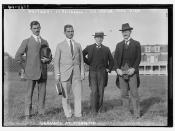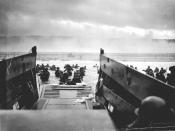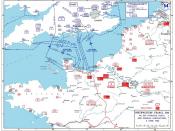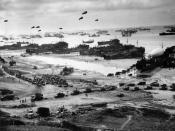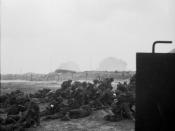D-Day (code-named "Operation Overlord") is remembered as maybe the greatest military attack of WWII, if not all of recorded history. It was a part of a plan devised by the Allied powers to take back Europe, starting with France. (The Allied Powers being the U.S., the Soviet Union, and Great Britain) The actual D-Day took place on June 4, 1944. At the beginning of WWII, Germany invaded Poland, causing France, Great Britain and Canada to declare war on Germany. By the spring of 1940, the German army was ready to invade France, which was defended not only by the French military, but a large British force as well. The Germans defeated the Allies and seized control of France within 6 weeks. This is why it was so crucial to regain control of the territory.
The attack caught the Germans very much off guard. The Normandy beaches that the Allies landed on were code named Utah, Omaha, Gold, Juno, and Sword beach.
The casualties from Omaha exceded the count from any of the beaches, Omaha was mainly occupied by American soldiers. Allied Planes pounded the Nazi defenders and dropped thousands of paratroopers behind German lines the night before the seaborn landings. American, British and Canadian troops met heavy resistance from the German forces defending the area but were able to go inland. Before the troops that had entered Normandy by the beaches could gain access to the mainland they had to overcome many obstacles. Among these obstacles were the Atlantic Wall, the Belgian gates teller mines, ramps, walls of barbed wire, minefields, pillboxes, hedgehogs, and concrete bunkers. Belgian gates were the 10-foot high steel structures that were set parallel to the beach. The teller mines were mines that were on post's that were angled seaward. Ramps were mine-tipped logs that were driven into the sand. Hedgehogs were mine-tipped obstacles that stood 6feet high and were constructed of steel rails welded together to rip off the bottoms of landing crafts at high tide. Walls of barbed wire and minefields criss-crossed the beach and paths leading on and off the beaches. Pillboxes were small concrete bunkers that shielded machine gun nests and antitank guns. Concrete bunkers were also used to protect 75-88mm guns. There were 12 strong points Widerstandnester ("resistance nests"). Numerous other fighting positions dotted the area supported by an extensive trench system. German gunners poured deadly fire upon anybody who dare set foot upon the beaches, if they made it that far. Bodies lay on the beach and floated in the water.
What makes D-Day so impressive over any other operation is its mass size. The confidentiality that was upheld is extremely impressive. Hundreds of people had to keep their mouths shut about the operation. The system occasionally broke down....The strangest breach of security came from the London Daily Telegraph, whose crossword puzzles alarmed BIGOT (Bigot officers were anybody who had special clearance in the London and southern England) security officers. One puzzle, on May 2, included "Utah" in its answers. Two weeks later, "Omaha" appeared as an answer. The puzzle's author, a schoolmaster, was placed under surveillance. Next came "Mulberry," code name for artificial harbors that were secretly being built in England for use off invasion beaches. Then came the most alarming answer of all: "Neptune." The schoolmaster was eventually arrested. As it would turn out the schoolmaster had asked his students for help in finding words. On of his students had overheard soldiers talking and these words had came up for obvious reasons and the student had reported them to his teacher.
By the end of one day, over 2,500 American soldiers out of the 34,000 troops that had landed, had lost their lives at battle. Oddly enough, or not. American lost more Allied soldiers than any other country by far, but was the last to build a memorial in their honor (it was not built until about a year ago).
